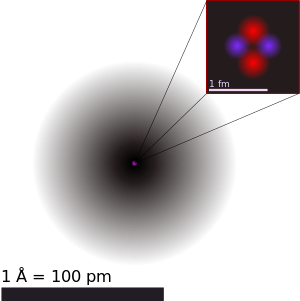
Back Atoom Afrikaans Atom ALS አቶም Amharic Atomo AN Mot ANG Atọm ANN परमाणु ANP ذرة Arabic درة ARY ذره ARZ
The "Scots" that wis uised in this airticle wis written bi a body that haesna a guid grip on the leid. Please mak this airticle mair better gin ye can. (Januar 2021) |
| Helium atom | ||||||||
|---|---|---|---|---|---|---|---|---|
 | ||||||||
| An illustration o the helium atom, depictin the nucleus (pink) an the electron clood distribution (black). The nucleus (upper richt) in helium-4 is in reality spherically symmetric an closely resembles the electron clood, awtho for mair complicatit nuclei this is nae ayeweys the case. The black baur is ane angstrom (10−10 m or 100 pm). | ||||||||
| Clessification | ||||||||
| ||||||||
| Properties | ||||||||
|
An atom is the smawest consteetuent unit o ordinary matter that haes the properties o a chemical element.[1] Ivery solit, liquid, gas, an plasma is componed o neutral or ionised atoms. Atoms are very smaw; teepical sizes are aroond 100 picometres (a ten-billiont o a metre, in the short scale).[2]
Atoms are smaw eneuch that attemptin tae predict thair behaviour uisin clessical physics - as if thay war billiard baws, for ensaumple - gies noticeably incorrect predictions due tae quantum effects. Throu the development o physics, atomic models hae incorporatit quantum principles tae better expleen an predict the behaviour.
Ivery atom is componed o a nucleus an ane or mair electrons boond tae the nucleus. The nucleus is made o ane or mair protons an teepically a seemilar nummer o neutrons. Protons an neutrons are cried nucleons. Mair nor 99.94% o an atom's mass is in the nucleus. The protons hae a positive electric chairge, the electrons hae a negative electric chairge, an the neutrons hae na electric chairge. If the nummer o protons an electrons are equal, that atom is electrically neutral. If an atom haes mair or fewer electrons nor protons, then it haes an oweraw negative or positive charge, respectively, an it is cried an ion.
The electrons o an atom are attractit tae the protons in an atomic nucleus bi this electromagnetic force. The protons an neutrons in the nucleus are attractit tae ilk ither bi a different force, the nuclear force, which is uisually stranger than the electromagnetic force repellin the positively charged protons frae ane anither. Unner certaint circumstances the repellin electromagnetic force becomes stranger nor the nuclear force, an nucleons can be ejectit frae the nucleus, leavin behind a different element: nuclear decay resultin in nuclear transmutation.
The nummer o protons in the nucleus defines tae what chemical element the atom belangs: for ensaumple, aw copper atoms conteen 29 protons. The nummer o neutrons defines the isotope o the element.[3] The nummer o electrons influences the magnetic properties o an atom. Atoms can attach tae ane or mair ither atoms bi chemical bonds tae form chemical compoonds sic as molecules. The abeelity o atoms tae associate an dissociate is responsible for maist o the physical chynges observed in naitur, an is the subject o the discipline o chemistry.
- ↑ "Atom". Compendium of Chemical Terminology (IUPAC Gold Book) (2nd ed.). IUPAC. Retrieved 25 Apryle 2015.
- ↑ Ghosh, D. C.; Biswas, R. (2002). "Theoretical calculation of Absolute Radii of Atoms and Ions. Part 1. The Atomic Radii". Int. J. Mol. Sci. 3: 87–113. doi:10.3390/i3020087.
- ↑ Leigh, G. J., ed. (1990). International Union of Pure and Applied Chemistry, Commission on the Nomenclature of Inorganic Chemistry, Nomenclature of Organic Chemistry – Recommendations 1990. Oxford: Blackwell Scientific Publications. p. 35. ISBN 0-08-022369-9.
An atom is the smallest unit quantity of an element that is capable of existence whether alone or in chemical combination with other atoms of the same or other elements.